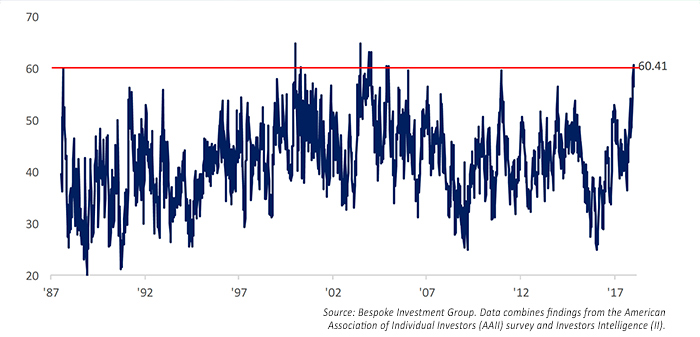
This week’s “How I See It” article by Canaccord Genuity’s Tony Dwyer explores the impact of extremely low bearish readings in recent surveys of financial newsletter writers by Investors Intelligence.
Mr. Dwyer’s analysis looks at sentiment extremes in both 1986–1987 and the current bull market, finding that some sharp market pullbacks did occur after these readings were recorded (four pullbacks of 5%–9% in 1986, two declines of 5%–7% in 2014, and a “more pronounced 14% pullback into early 2016.”) All of these instances of “low bearish extremes” were followed by record market highs in a relatively brief period.
There is a counterargument to this analysis that creates a small note of caution, however, if one looks at bullish sentiment readings versus bearish readings.
First, looking at the Investors Intelligence survey of financial newsletter writers, Bespoke Investment Group notes that “two-thirds of newsletter writers consider themselves bullish, and that’s the highest level for this survey since April 1986!”
FIGURE 1: INVESTORS INTELLIGENCE BULLISH SENTIMENT (CURRENT BULL MARKET)

Bespoke points out that in the last 30 years, there have only been four occurrences of average bullish sentiment readings over 60% (taking the average of individual investors represented in the American Association of Individual Investors (AAII) survey and the Investors Intelligence survey of financial newsletter writers).
FIGURE 2: AVERAGE BULLISH SENTIMENT (1987–2018)

One such period was just before the 1987 market crash, one was in the run-up to the dot-com bubble and subsequent bear market of the early 2000s, one was during the relatively bullish period of 2003–2004, and one is right now. Despite two out of four scary occurrences, Bespoke says it is “no time for bulls to freak out.”
They find encouraging—“counter to long-term conventional wisdom”—the fact that rising interest rates in the current bull market have been favorable for equities.
Bespoke says,
- “The S&P 500’s average return during periods of rising 10-year yields has been a gain of 19.2%, with positive returns every time.”
- “During periods when the 10-year yield was falling, the S&P 500’s average return was actually a decline of 0.5%, with gains 63% of the time.”
- “Barring a major spike higher, it likely won’t be until the yield on the 10-year Treasury gets well above 3% that ‘rising rates’ will become problematic.”
